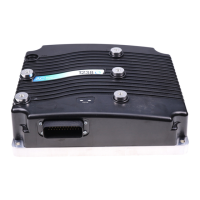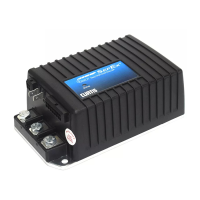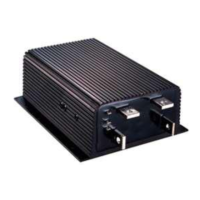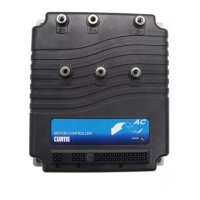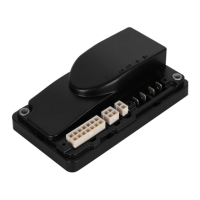7 — DIAGNOSTICS AND TROUBLESHOOTING
Curtis AC F4-A Motor Controller – August 2020 Return to TOC
pg. 158
The Flash Code listed in the first column of Table 18 (Troubleshooting Chart) includes the
hexadecimal representation of the code. For example;
(1) Flash code 1-2 for the OVERCURRENT fault equates to 0x12, and is reported in Data Bytes 0 &
1 using the Little-Endian format as FF12h (0xFF12). is is represented on the controller’s LEDs
with the rst digit (“1”) the red LED and the second digit (“2”) the yellow LED. e controller will
“ash” the red LED 1-time followed by yellow LED 2-times (LEDs x1 x2) in the decimal equivalent.
(2) Flash code 9-A for the INTERLOCK BRAKING SUPERVISION fault equates to 0x9A, and will
be reported in Data Bytes 0 & 1 as FF9Ah (0xFF9A). is is represented on the controller’s LEDs
with the rst digit (“9”) the red LED and the second digit (“A”) the yellow LED. e controller
will “ash” the red LED 9-times followed by yellow LED 10-times (LEDs x9 x10) in the decimal
equivalent (9h = 9d, Ah = 10d).
Data Byte 2 – Error Register
is byte mirrors the state of the LSB of the predened Error Register object 1001h. is byte is 00h
if there are no faults and 01h if there are any faults in the device.
Data Bytes 3 & 4 – Fault Record Object Index
e Fault Record Object is the fault’s CAN Object Index, thus distinguishing faults sharing the same
LED ash codes. For the controller, these objects are stored in indexes 2100h through 27FFh. When
no error is present (fault cleared) these bytes will be all 0000h.
Data Byte 5 through 7 – Descriptor
Data Byte 5 indicates the fault’s “type” as indicated in the troubleshooting chart, Table 17, below.
Several examples of the CANbus error messages illustrate the CAN Emergency messages. Example
(1) is a single fault type, whereas example (2a-b) has two error types, which help to dened the root-
cause of the fault. Example (3a-b) shares the same ash code, where the Fault Record Object provide
the actual fault detected.
1. CANbus Emergency Message: Motor_Temp_Sensor_Active | 0x2150 0x01
Motor Temp Sensor fault. Flash code 2-9 (LEDs: x2 x9)
Identier DLC Data
0A6 8 00 00 00 00 00 01 00 00
In this example, Device ID = 26h (38d). Note the “little-endian” byte-ordering for the error
code (flash code) and fault record object index. Data Byte 5 further defines the fault as per its
type. In this case, there is only a single type, resulting in 01. The 11-bit Identifier assembles as:
A6h = 00 01 | 0 1 0 0 1 1 0, where the top 4 bits are the Sync-Error Function code, and the bottom
7 bits are the Node ID, as explained above.
If this fault were to clear, while the controller is operational, the CANbus message will clear:
Identier DLC Data
0A6 8 00 00 00 00 00 01 00 00
2a. CANbus Emergency Message: Main_Contactor_Did_Not_Close_Active | 0x2221 0x01
Main Contactor Did Not Close fault. Flash code 3-9 (LEDs: x3 x9)
Identier DLC Data
0A6 8 39 FF 01 21 22 01 00 00
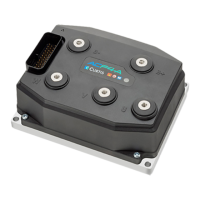
